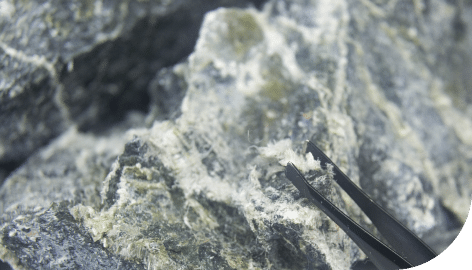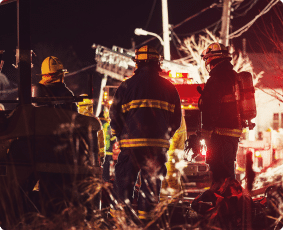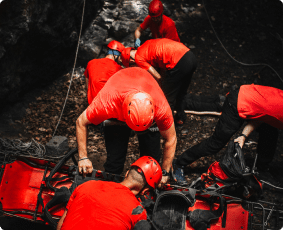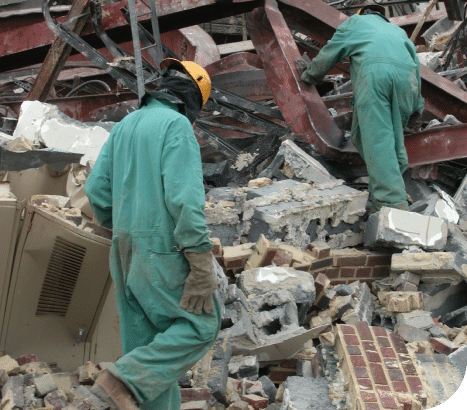First Responders and Mesothelioma
First responders sacrifice their safety to save others, often venturing into damaged buildings and other environments where invisible asbestos fibers are present in high concentrations. As a result, first responders face a higher-than-average risk of developing mesothelioma and other life-threatening illnesses.
Home » National Mesothelioma Law Firm » Asbestos Exposure » Occupational Asbestos Exposure » First Responders and Mesothelioma
- Medically Reviewed By: Patricia Shelton, M.D.
- Legally Review By: Megan Waida
- Page Last Updated:
- March 14, 2024
Asbestos Exposure Risks for First Responders
First Responders and the September 11, 2001, Terrorist Attacks
Why are First Responders Still at Risk?
What Asbestos Building Materials Do First Responders Encounter?
Who is Liable for First Responder Asbestos Exposure?
What Compensation is Available to First Responders with Mesothelioma?
The destruction of asbestos-containing materials causes microscopic asbestos fibers to become airborne. First responders such as firefighters, paramedics, and law enforcement officers often enter buildings damaged by fire, natural disasters, vandalism, and age where airborne asbestos fibers may be present.
Asbestos exposure is the only known cause of mesothelioma. The mesothelioma lawyers at the Lanier Law Firm help first responders with mesothelioma and other asbestos-related health conditions recover substantial compensation.

Asbestos Exposure Risks for First Responders
First responders are frequently exposed to heavy levels of asbestos over an extended period and can face an increased risk of developing mesothelioma, lung cancer, and asbestosis later in life. First responders are most likely exposed to asbestos while providing emergency services in buildings with damaged asbestos materials.
Asbestos was a popular building material before its harmful effects became public in the late 1970s. That’s when first responders likely faced the highest levels of asbestos exposure. The mesothelioma latency period ranges from 10 to 60 years. As a result, first responders who worked during this period are still being diagnosed with mesothelioma today.
Although asbestos is generally not used in construction today, buildings constructed before 1990 may contain asbestos. Asbestos is generally not considered hazardous if a licensed asbestos abatement contractor has determined it to be non-friable. Non-friable means the asbestos is encased in a building material that is not easily damaged.
However, when the encasement materials become damaged during emergencies, asbestos can be released into the environment, endangering the long-term health of emergency workers who must enter these buildings to save lives.
Comfort Measures
Firefighters face the highest asbestos exposure levels of all first responders because they must frequently enter buildings damaged by fire. As recently as May 2021, 115 firefighters were likely exposed to asbestos in an Austin, Texas, warehouse fire, according to KXAN News.
Encasement materials can be destroyed by a fire, releasing asbestos fibers into the air. Unfortunately, asbestos’s fire-resistant properties prevent the mineral from destruction by building fires, so asbestos fibers remain harmful to humans.

In fact, before the dangers of asbestos were known, firefighters often wore personal protective equipment that contained asbestos because of the fire-resistant nature of this mineral. Family members were also exposed when this equipment was worn or laundered at home. This is known as secondary exposure. Although personal protective equipment no longer contains asbestos, secondary exposure can still result if asbestos fibers land on it during a fire, and the firefighter then takes the gear home.
Firefighters also participate in rescue operations following natural disasters and other emergencies in environments where asbestos may have been released. They are often the first emergency personnel to arrive at the scene of an emergency.
Emergency Medical Service Workers
Emergency medical service workers often work alongside firefighters and provide life-saving health stabilization and ambulance transportation to the nearest hospital. Emergency medical workers include the following:
- Emergency medical responders (EMRs)
- Emergency medical technicians (EMTs)
- Advanced emergency medical technicians (AEMTs)
- Paramedics
- Dual-function firefighter-paramedics

Emergency medical workers may be exposed to asbestos while performing on-site emergency services. Exposure may occur in confined spaces of buildings damaged by fires, floods, tornadoes, and hurricanes. If asbestos fibers land on clothing or protective gear during rescue efforts, they can also contaminate the ambulance’s interior. This can lead to secondary exposure for others who later use the vehicle.
The Journal of Emergency Medical Services reports that emergency medical services in the United States are severely underfunded, and workers often lack the personal protective equipment to stay safe while doing their jobs.
Search and Rescue Workers
Search and rescue workers are often called upon to locate people buried under piles of building rubble in catastrophically damaged buildings as a result of the following:
- Explosions
- Fires
- Earthquakes
- Hurricanes
- Tornadoes
- Floods

It is not uncommon for rescue workers to spend significant time in structures with damaged power lines, burst steam pipes, broken gas lines, collapsed structural steel, and completely fallen buildings. In older structures, these building materials likely contain asbestos, which may become airborne when these components are damaged.
Search and rescue workers may have to move these components to locate and rescue victims. Directly handling these materials may expose workers to high concentrations of asbestos, increasing their long-term health risks.
Law Enforcement
Law enforcement officers are called for many types of emergencies and often lack the personal protective equipment necessary to prevent inhalation of asbestos fibers.
Fire and Rescue
Law enforcement often assists firefighters and emergency medical workers in the same high-risk environments. Officers provide security, crime scene investigation, and basic first aid, often without personal protective equipment. According to the International Association of Chiefs of Police, some officers also work as paramedics and firefighters.

Police Emergencies
Police respond to a wide range of emergency calls when the circumstances are unclear. For example, the Daily Democrat reported in 2017 that Baltimore police officers might have been exposed to asbestos when responding to an underground steam pipe explosion.
The unpredictable nature of their jobs often deprives them of the opportunity to anticipate potential asbestos exposure and dress accordingly. They also respond to emergencies stemming from violent crime, burglaries, and vandalism, all of which may result in property damage like the following, which could contain asbestos:
- Bullet holes that damage drywall, paint, and insulation
- Vandalism that damages bricks, drywall, insulation, siding, paint, structural steel, cement, or roofing materials
- Locks, doors, and safes damaged during burglaries
- Drywall and insulation damaged in domestic violence situations
Proper use of personal protective equipment requires decontamination procedures that take extensive time. Police must move quickly from one scene to the next and may be unable to take the time to manage personal protective equipment.
Disadvantaged Neighborhoods
The Department of Housing & Urban Development (HUD) has observed that crime is most common in disadvantaged neighborhoods. Police officers typically perform the highest percentage of law enforcement activities in these areas.
These neighborhoods are more likely to consist of older homes, school buildings, and businesses with poorly-maintained infrastructure, increasing the likelihood of asbestos exposure. Financial limitations in these areas may prevent homeowners, business owners, and schools from testing and abating asbestos.
As a result, police officers may be exposed to airborne asbestos while performing law enforcement activities in these locations.
Police Headquarters
Police stations are often located in older buildings containing asbestos. According to a 2021 report by the Stamford Advocate in Connecticut, police had to move out of their headquarters due to the presence of asbestos.
First Responders and the September 11, 2001, Terrorist Attacks
The September 11, 2001, collapse of the World Trade Center in New York following the terrorist attacks released up to 400 tons of asbestos. A toxic dust plume containing high concentrations of asbestos and other toxic substances covered bystanders, clean-up crews, and first responders.
First responders worked extensive hours in the epicenter of the toxic plume for many days following the attacks. These workers included the following first responders from New York and throughout the United States:
- Firefighters
- Police officers
- Search and Rescue Workers
- Emergency medical services
- National Guardsmen
First responders exposed to the toxic plume during 9/11 have begun developing mesothelioma and other cancers. The first 9/11 mesothelioma death occurred in 2018, and hundreds more cases are likely.
Why are First Responders Still at Risk?
State and federal asbestos regulations require commercial buildings containing asbestos to undergo periodic inspections and abatement as necessary. Asbestos is generally allowed to remain in place if it is non-friable. While this helps to mitigate risks for building occupants and some workers, it does nothing to reduce the risks for first responders who must work in the building following its destruction.
What Asbestos Building Materials Do First Responders Encounter?
When asbestos use was unrestricted, it could be found in virtually every building component from the rooftop to even below the foundation. First responders may encounter asbestos in the following building components:
- Cement
- Electrical wiring
- Plaster
- Paint
- Adhesives
- Bricks
- Siding

Who is Liable for First Responder Asbestos Exposure?
First responders may have been exposed to many asbestos sources during a lifetime of working in the field. As a result, numerous parties may be liable for first responder mesothelioma. These include the following:
- Government and private employers
- Workers’ compensation
- Commercial building owners that failed to follow asbestos regulations
- Companies that manufactured or supplied asbestos products
What Compensation is Available to First Responders with Mesothelioma?
Our mesothelioma lawyers at the Lanier Law Firm help first responders identify as many exposure sources as possible to ensure you receive the maximum compensation available.
Workers’ Compensation for First Responders
First responders with mesothelioma often qualify for workers’ compensation. While Workers’ compensation functions slightly differently in each state, it generally provides partial wage replacement and medical care. To qualify for partial wage replacement, you generally must still be working.
Most states pay approximately two-thirds of your average wage during the most recent 12-month period of your employment, but the exact amount varies by state. Benefits may be paid weekly, bi-weekly, or monthly.
If workers’ compensation covers your mesothelioma, you generally cannot sue your employer. Independent contractors are generally not covered, but most employees are. If you are a volunteer firefighter, you may qualify for workers’ compensation, depending on your state.
9/11 First Responder Programs
If you were a first responder to the 9/11 terrorist attacks, you might be eligible to receive no-cost medical monitoring and treatment for mesothelioma and other related conditions. Whether you responded to the World Trade Center, Pentagon, or Shanksville, Pennsylvania site, these benefits are available.
You may also file a claim for compensation through the Victims Compensation Fund, which offers up to $250,000 for lost wages, medical expenses, and pain and suffering related to your 9/11 exposure.
If your loved one was a first responder who passed away after contracting asbestos-related cancer due to 9/11, you also have the right to file a claim through the Victims’ Compensation Fund.

Mesothelioma Lawsuits
If you are ineligible for workers’ compensation, you may have grounds to file a mesothelioma lawsuit against your employer for your asbestos exposure in the field. You may also be able to file a lawsuit against a commercial building owner and any companies that supplied the asbestos to your exposure sources.
The state, local, or federal government agency that employed you should have a written record of the emergency calls to which you responded. Our experienced mesothelioma attorneys may be able to identify multiple exposure sources through these records and identify the responsible companies.
The compensation available through a mesothelioma lawsuit may include the following:
- Economic damages – verifiable financial losses, such as medical expenses, lost wages, and loss of earning capacity
- Non-economic damages – subjective losses to your quality of life, such as pain, suffering, and loss of society
- Punitive damages – damages awarded as a punishment against asbestos companies that engaged in fraudulent concealment, gross negligence, and deliberate misconduct
Some states limit the non-economic and punitive damages available in personal injury cases, and some do not allow punitive damages. Our attorneys are often successful in moving cases to more favorable venues.
Asbestos Trust Funds
If the company liable for your asbestos-related illness has filed for bankruptcy, you may still be able to recover compensation by filing a claim through an asbestos trust fund. You can file a claim directly with the asbestos trust fund rather than with the court and recover economic and non-economic damages through the trust.
However, you will need to know which company is responsible for your asbestos exposure and be able to prove your claim. Our asbestos trust fund attorneys can handle this and help you recover the maximum trust fund compensation available.
How Can the Lanier Law Firm Help?
The Lanier Law Firm is one of the most experienced mesothelioma law firms in the world, with more than 25 years of experience helping people with mesothelioma and other devastating illnesses hold asbestos companies accountable and recover substantial compensation.
While financial compensation cannot reverse a mesothelioma diagnosis, it can provide financial security for you and your family while ensuring you have access to the most advanced mesothelioma treatment available. We have a long track record of consistently getting remarkable settlements and verdicts for our clients.
When you retain the Lanier Law Firm, you can count on our compassionate attorneys to fight for you to recover the compensation you deserve. If you are a first responder or former first responder with mesothelioma or another asbestos-related illness, contact us today to schedule a free consultation.
By submitting this form, you agree to our terms & conditions. Please read the full disclaimer



